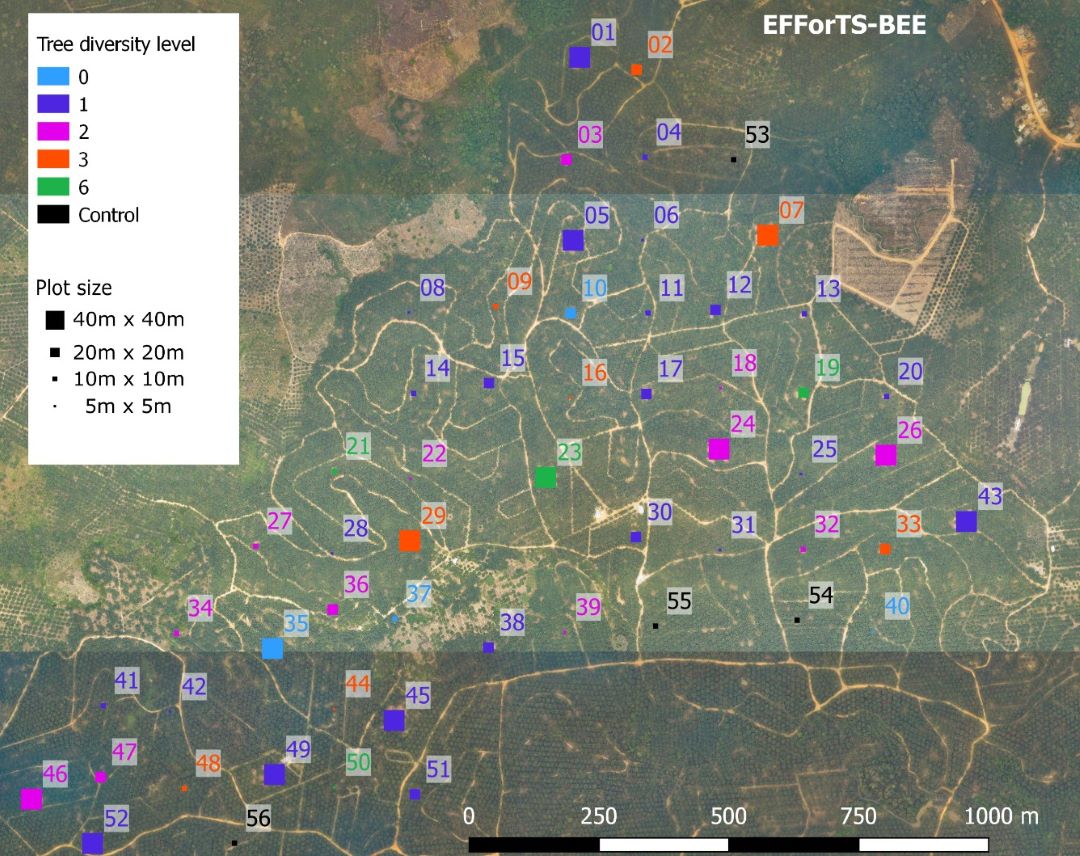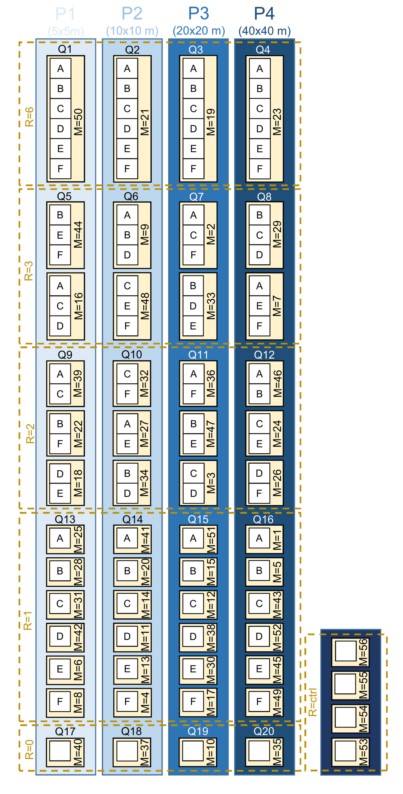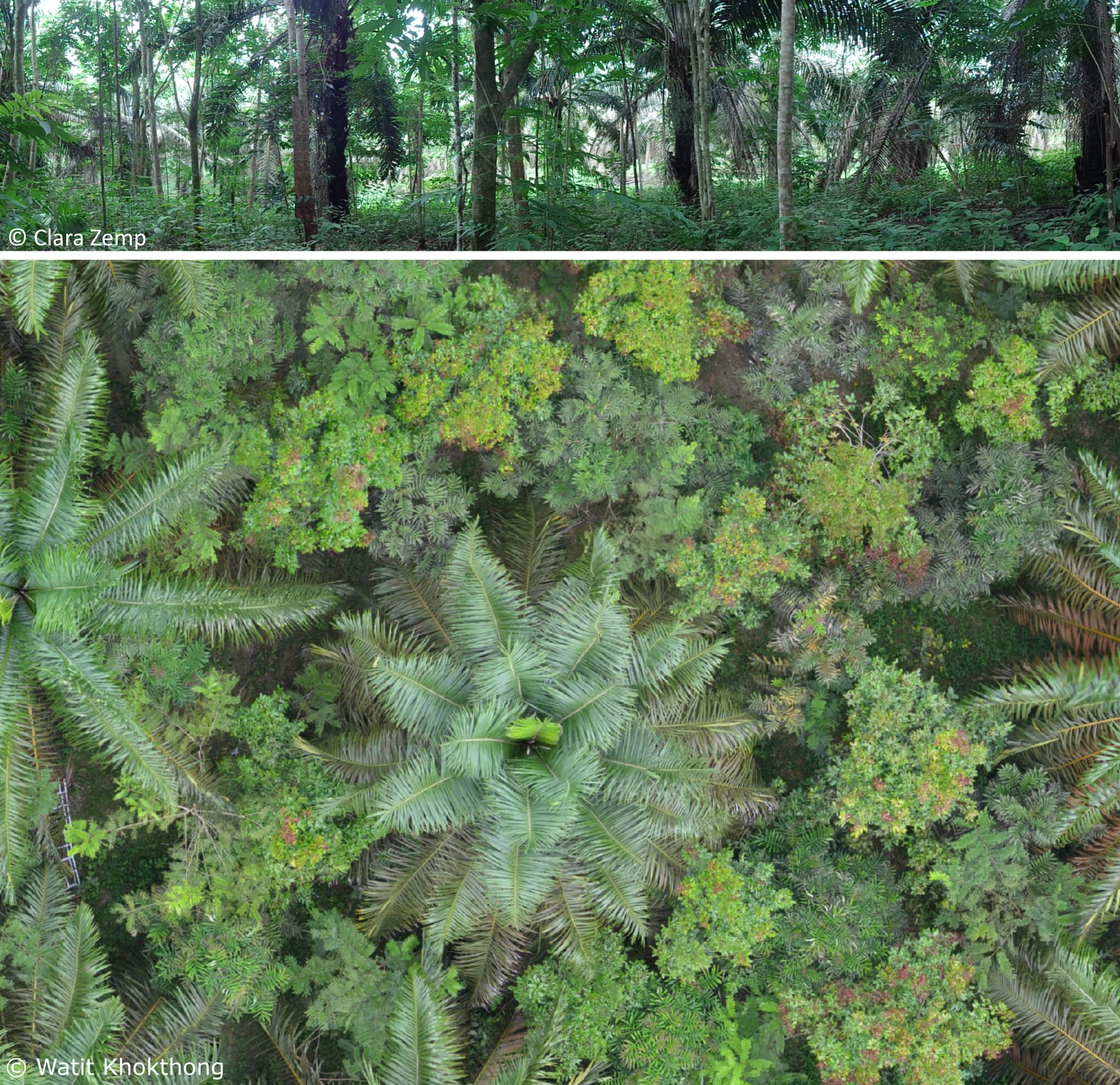EFForTS-BEE (Indonesia)
A biodiversity enrichment experiment was established as part collaborative research center EFForTS [Ecological and socio-economic functions of tropical lowland rainforest transformation systems (Sumatra, Indonesia)] funded by the German Research Foundation. Tree islands were planted in a monoculture oil palm plantation in December 2013. The aim of the enrichment experiment is to analyse trade-offs between ecological and economic functions and to contribute to the development of ecologically improved management concepts in oil palm landscapes.

Design
The experiment consists of 52 tree islands planted in a monoculture oil-palm landscape, with a minimum distance of 85 m between them. The islands, i.e., plots, vary in tree species composition and diversity following a random partitions design. The experiment comprises four partitions that differ in plot size (5 m x 5 m, 10 m x 10 m, 20 m x 20 m, 40 m x 40 m). Each partition is divided into five blocks, one per tree diversity level (0, 1, 2, 3, and 6 species). Within each block, each species was randomly drawn from the species pool without replacement and thus selected exactly once Before planting, approximately 40 % of the oil palms on the plots were removed to enhance the light availability. Trees were planted with a 2-m grid spacing, and the distance between trees belonging to the same species was maximized. We planted six trees on the 5 m x 5 m plots, 25 trees on the 10 m x 10 m plots, 100 trees on the 20 m x 20 m plots and 400 on the 40 m x 40 m plots.

Site characteristics
| EFForTS-BEE (Bungku village) | |
|---|---|
| Country | Indonesia |
| Biome | tropical |
| Latitude | -1.95 |
| Longitude | 103.3 |
| Soil type | loamy Acrisol |
| Former land use | oil palm monoculture plantation |
| Altitude | 36-58 m |
| Design | regular alternate |
| Plot shape | rectangular |
| Plot size (m^2) | 25 m² 100 m² 400 m² 1600 m² |
| Plant distance (m) | 2 |
| Number of trees planted | 6354 |
| Planting date | December 2013 |
| Diversity variables | species richness |
| Diversity gradient | 0, 1, 2, 3, 6 sp. |
| Size species pool | 6 |
| Species pool | Archidendron jiringa Durio zibethinus Dyera polyphylla Parkia speciosa Peronema canescens Shorea leprosula |
| Contact person | Gustavo Paterno Holger Kreft Meike Wollni Dirk Hoelscher |
| gustavo.paterno@uni-goettingen.de holger.kreft@forst.uni-goettingen.de mwollni1@gwdg.de dhoelsc@gwdg.de |
Research
Three main questions are investigated: (1) Are gap enrichment plantings a suitable measure for biodiversity enrichment in oil palm plantations? (2) Do tree islands act as nuclei for colonization of flora and fauna? (3) What are the socio-economic and ecological trade-offs?
Within a few years after planting, tree diversity and plot size enhanced tree growth and stand structural complexity; it is, however, still much lower than that of forests and the long-term temporal trajectories are unclear. Native tree species spontaneously colonized the experimental plots but also invasive plant species thrived. Overall, the experimental effects on the biodiversity of birds, plants and other taxa were mixed. After an initial increase in oil palm yield, we are beginning to see a decline that coincides with the incipient competition between trees and palms.
For Phase 3 (2020-2023), we work on four work packages (1) tree dynamics and yield, (2) plant successional trajectories, (3) scenarios and upscaling, and (4) integration and synthesis. Research will focus on the role of invasive plants and landscape configuration as potential drivers of ecological disservices, recruitment limitations and restoration success, as well as on determinants of performance and function of trees. Other studies addressing the changes in the environment, biodiversity & ecological functions, and economic functions will be integrated and led towards a synthesis. We will test for the role of direct and indirect effects of biodiversity restoration.
Extra information
Send an e-mail to the contact persons, explore the website of the experiment, go on a interactive field tour (here or here) or explore the publications that utilized data from this experiment.
PhD thesis
- Khokthong W 2019 Drone-based assessments of crowns, canopy cover and land use types in and around an oil palm agroforestry experiment. PhD Thesis, University Of Göttingen.
- Gérard A 2016 Experimental biodiversity enrichment in an oil-palm plantation. PhD thesis, University Of Göttingen.
- Teusher M 2015 Ecological impacts of biodiversity enrichment in oil palm plantations. PhD thesis, University Of Göttingen.
Research papers
- Blondeel H, Guillemot J, Martin‐StPaul N, Druel A, Bilodeau‐Gauthier S, Bauhus J, … Baeten L 2024 Tree diversity reduces variability in sapling survival under drought. Journal of Ecology 112(5): 1164-1180 - https://doi.org/10.1111/1365-2745.14294
- Kikuchi T, Seidel D, Ehbrecht M, Zemp DC, Brambach F, Irawan B, Sundawati L, Hölscher D, Kreft H, Paterno GB 2024 Combining planting trees and natural regeneration promotes long-term structural complexity in oil palm landscapes. Forest Ecology and Management 569: 122182 - doi.org/10.1016/j.foreco.2024.122182
- Luo S, Schmid B, Hector A, Scherer‐Lorenzen M, Verheyen K, Barsoum N, Bauhus J, Beyer F, Bruelheide H, Ferlian O, Godbold D, Hall JS, Hajek P, Huang Y, Hölscher D, Kreft H, Liu X, Messier C, Nock C, Paquette A, Parker JD, Parker WC, Paterno GB, Reich PB, Rewald B, Sandén H, Sinacore K, Stefanski A, Willams L, Eisenhauer N 2024 Mycorrhizal associations modify tree diversity− productivity relationships across experimental tree plantations. New Phytologist 243:1205-1219 - doi: 10.1111/nph.19889
- Montoya-Sánchez V, Camarretta N, Ehbrecht M, Schlund M, Paterno GB, Seidel D, Guerrero-Ramírez N, Brambach F, Hölscher D, Kreft H, Irawan B, Sundawati L, Zemp DC 2024 Comparing airborne and terrestrial LiDAR with ground-based inventory metrics of vegetation structural complexity in oil palm agroforests. Ecological Indicators 166: 112306 - doi.org/10.1016/j.ecolind.2024.112306
- Paterno GB, Brambach F, Guerrero-Ramírez N, Zemp DC, Cantillo AF, Camarretta N, Moura CC, Gailing O, Ballauff J, Polle A, Schlund M, Erasmi S, Iddris NA, Khokthong W, Sundawati L, Irawan B, Hölscher D, Kreft H 2024 Diverse and larger tree islands promote native tree diversity in oil palm landscapes. Science 386(6723): 795-802 - doi: 10.1126/science.ado1629
- Wenzel A, Westphal C, Ballauff J, Berkelmann D, Brambach F, Buchori D, Camarretta N, Corre MD, Daniel R, Darras K, Erasmi S, Formaglio G, Hölscher D, Iddris NA, Irawan B, Knohl A, Kotowska M, Krashevska V, Kreft H, Mulyani Y, Mußhoff O, Paterno GB, Polle A, Potapov A, Röll A, Scheu S, Schlund M, Schneider D, Sibhatu KT, Stiegler C, Sundawati L, Tjoa A, Tscharntke T, Veldkamp E, Waite P-A, Wollni M, Zemp DC, Grass I 2024 Balancing economic and ecological functions in smallholder and industrial oil palm plantations. Proceedings of the National Academy of Sciences 121:e2307220121 - doi.org/10.1073/pnas.2307220121
- Depauw L, De Lombaerde E, Dhiedt E, Blondeel H, Abdala-Roberts L, Auge H, Barsoum N, Bauhus J, Chu C, Damtew A, Eisenhauer N, V. Fagundes M, Ganade G, Gendreau-Berthiaume B, Godbold D, Gravel D, Guillemot J, Hajek P, Hector A, Hérault B, Jactel H, Koricheva J, Kreft H, Liu X, Mereu S, Messier C, Muys B, Nock CA, Paquette A, Parker JD, Parker WC, Paterno, GB, Perring MP, Ponette Q, Potvin C, Reich PB, Rewald B, Scherer-Lorenzen M, Schnabel F, Sousa-Silva R, Weih M, Clara Zemp D, Verheyen K, Baeten L 2024 Enhancing Tree Performance Through Species Mixing: Review of a Quarter-Century of TreeDivNet Experiments Reveals Research Gaps and Practical Insights. Current Forestry Reports - https://doi.org/10.1007/s40725-023-00208-y
- Li K, Grass I, Zemp DC, Lorenz H, Sachsenmaier L, Nurdiansyah F, Hölscher D, Kreft H, Tscharntke T 2023 Tree identity and canopy openness mediate oil palm biodiversity enrichment effects on insect herbivory and pollination. Ecological Applications, e2862 - https://doi.org/10.1002/eap.2862
- Montoya-Sánchez V, Kreft H, Arimond I, Ballauf J, Berkelmann D, Brambach F, Daniel R, Grass I, Hines J, Hölscher D, Irawan B, Krause A, Polle A, Potapov A, Sachsenmaier L, Scheu S, Sundawati L, Tscharntke T, Zemp DC, Guerrero-Ramírez N 2023 Landscape heterogeneity and soil biota are central to multi-taxa diversity for oil palm landscape restoration. Communications Earth & Environment (4)1: Article 1 - https://doi.org/10.1038/s43247-023-00875-6
- Zemp DC, Guerrero-Ramirez N, Brambach F, Darras K, Grass I, Potapov A, Röll A, Arimond I, Ballauff J, Behling H, Berkelmann D, Biagioni S, Buchori D, Craven D, Daniel R, Gailing O, Ellsäßer F, Fardiansah R, Hennings N, Irawan B, Khokthong W, Krashevska V, Krause A, Kückes J, Kreft H 2023 Tree islands enhance biodiversity and functioning in oil palm landscapes
- FAO 2023 Towards more resilient and diverse planted forests. Unasylva (254)74: 2031/1. Rome. https://doi. org/10.4060/cc8584en
- Azhar A, Tawakkal MI, Sari A, Rizali A, Tarigan SD, Nazarreta R, Buchori D 2022 Tree diversity enhance species richness of beneficial insect in experimental biodiversity enrichment in oil palm plantation. International Journal of Oil Palm 5(2): 39–49 - https://doi.org/10.35876/ijop.v5i2.82
- Korol Y, Khokthong W, Zemp DC, Irawan B, Kreft H, Hölscher D 2021 Scattered trees in an oil palm landscape: Density, size and distribution. Global Ecology and Conservation e01688 - https://doi.org/10.1016/j.gecco.2021.e01688
- Somenguem LD, Röll A, Ellsäßer F, Ehbrecht M, Irawan B, Hölscher D, Knohl A, Kreft H, Siahaan EJ, Sundawati L, Stiegler C, Zemp DC 2021 Microclimate and land surface temperature in a biodiversity enriched oil palm plantation. Forest Ecology and Management 497(119480) - https://doi.org/10.1016/j.foreco.2021.119480
- Tarigan S, Buchori D, Siregar IZ, Azhar A, Ullyta A, Tjoa A, Edy N 2021 Agroforestry inside oil palm plantation for enhancing biodiversity-based ecosystem functions. IOP Conference Series: Earth and Environmental Science 694(1): 012058 - https://doi.org/10.1088/1755-1315/694/1/012058
- Darras KFA, Yusti E, Huang JC, Zemp D, Kartono AP, Wanger TC 2021 Bat point counts: A novel sampling method shines light on flying bat communities. Ecology and Evolution 11(23) 17179–17190 - https://doi.org/10.1002/ece3.8356
- Messier C, Bauhus J, Sousa-Silva R, Auge H, Baeten L, Barsoum N, Bruelheide H, Caldwell B, Cavender-Bares J, Dhiedt E, Eisenhauer N, Ganade G, Gravel D, Guillemot J, Hall JS, Hector A, Hérault B, Jactel H, Koricheva J, Kreft H, Mereu S, Muys B, Nock CA, Paquette A, Parker JD, Perring MP, Ponette Q, Potvin C, Reich PB, Scherer-Lorenzen M, Schnabel F, Verheyen K, Weih M, Wollni M, Zemp DC 2021 For the sake of resilience and multifunctionality, let’s diversify planted forests! Conservation Letters e12829 - https://doi.org/10.1111/conl.12829
- Ballauff J, Zemp DC, Schneider D, Irawan B, Daniel R, Polle A 2020 Legacy Effects Overshadow Tree Diversity Effects on Soil Fungal Communities in Oil Palm-Enrichment Plantations. Microorganisms 8:1577 - https://www.mdpi.com/2076-2607/8/10/1577
- Merten J, Stiegler C, Hennings N, Purnama, ES, Röll A, Agusta H, Dippold MA, Fehrmann L, Gunawan D, Hölscher D, Knohl A, Kückes J, Otten F, Zemp DC, Faust H 2020 Flooding and land use change in Jambi Province, Sumatra: integrating local knowledge and scientific inquiry. Ecology and Society 25(3): 14 - https://doi.org/10.5751/ES-11678-250314
- Khokthong W, Zemp DC, Irawan B, Sundawati L, Kreft H, Hölscher D 2019 Drone-based assessment of canopy cover for analyzing tree mortality in an oil palm agroforest. Frontiers in Forests and Global Change 2: 1–10 - https://doi.org/10.3389/ffgc.2019.00012
- Seidel D, Annighöfer P, Stiers M, Zemp CD, Burkardt K, Ehbrecht M, Willim K, Kreft H, Hölscher D, Ammer C 2019 How a measure of tree structural complexity relates to architectural benefit‐to‐cost ratio, light availability, and growth of trees. Ecology and Evolution 9(12): 7134–7142 - https://doi.org/10.1002/ece3.5281
- Zemp DC, Ehbrecht M, Seidel D, Ammer C, Craven D, Erkelenz J, Irawan B, Sundawati L, Hölscher D, Kreft H 2019 Mixed-species tree plantings enhance structural complexity in oil palm plantation. Agriculture, Ecosystems and Environment, 283: 106564 - doi: https://doi.org/10.1016/j.agee.2019.06.003
- Zemp DC, Gérard, A, Hölscher D, Ammer C, Irawan B, Sundawati L, Teuscher M, Kreft H 2019 Tree performance in a biodiversity enrichment experiment in an oil palm landscape. Journal of Applied Ecology 56: 10 - doi: https://doi.org/10.1111/1365-2664.13460
- Grossman JJ, Vanhellemont M, Barsoum N, Bauhus J, Bruelheide H, Castagneyrol B, Cavender-Bares J, Eisenhauer N, Ferlian O, Gravel D, Hector A, Jactel H, Kreft H, Mereu S, Messier C, Muys B, Nock C, Paquette A, Parker J, Perring MP, Ponette Q, Reich PB, Schuldt A, Staab M, Weih M, Zemp DC, Scherer-Lorenzen M, Verheyen K 2018 Synthesis and future research directions linking tree diversity to growth, survival, and damage in a global network of tree diversity experiments. Environmental and Experimental Botany 152: 68-89 - doi: 10.1016/j.envexpbot.2017.12.015
- Gérard A, Wollni M, Höscher D, Irawan B, Sundawati L, Teuscher M, Kreft H 2017 Oil-palm yields in diversified plantations: Initial results from a biodiversity enrichment experiment in Sumatra, Indonesia. Agriculture, Ecosystems and Environment 240: 253-260 - doi: http://doi.org/10.1016/j.agee.2017.02.026
- Teuscher M, Gérard A, Brose U, Buchori D, Clough Y, Ehrbrecht M, Hölscher D, Irawan B, Sundawati L, Wollni M, Kreft H 2016 Experimental biodiversity enrichment in oil-palm-dominated landscapes in Indonesia. Frontiers in Plant Science 7: 1538 - doi: 10.3389/fpls.2016.01538
